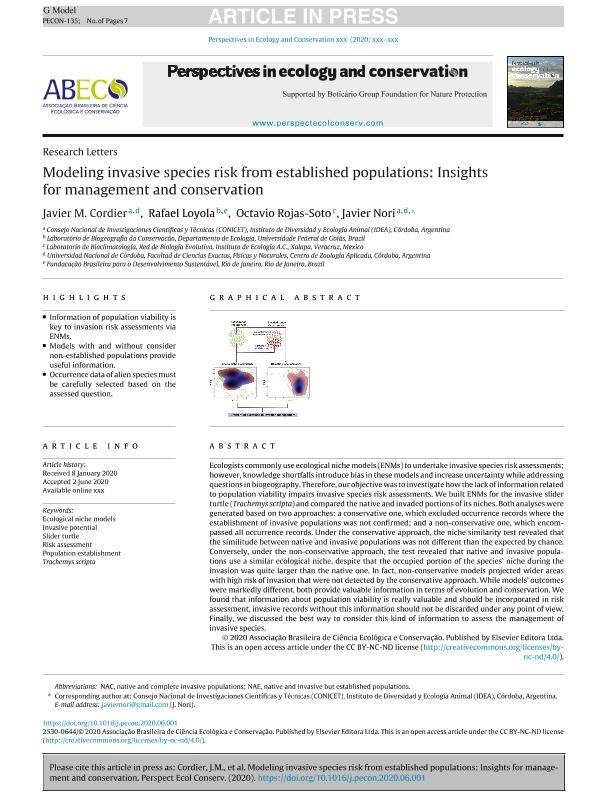Mostrar el registro sencillo del ítem
dc.contributor.author
Cordier, Javier Maximiliano

dc.contributor.author
Loyola, Rafael

dc.contributor.author
Rojas-Soto, Octavio
dc.contributor.author
Nori, Javier

dc.date.available
2021-09-21T11:14:10Z
dc.date.issued
2020-04
dc.identifier.citation
Cordier, Javier Maximiliano; Loyola, Rafael; Rojas-Soto, Octavio; Nori, Javier; Modeling invasive species risk from established populations: Insights for management and conservation; Associacao Brasileira de Ciencia Ecologica e Conservacao; Perspectives in Ecology and Conservation; 18; 2; 4-2020; 132-138
dc.identifier.issn
2530-0644
dc.identifier.uri
http://hdl.handle.net/11336/140944
dc.description.abstract
Ecologists commonly use ecological niche models (ENMs) to undertake invasive species risk assessments; however, knowledge shortfalls introduce bias in these models and increase uncertainty while addressing questions in biogeography. Therefore, our objective was to investigate how the lack of information related to population viability impairs invasive species risk assessments. We built ENMs for the invasive slider turtle (Trachemys scripta) and compared the native and invaded portions of its niches. Both analyses were generated based on two approaches: a conservative one, which excluded occurrence records where the establishment of invasive populations was not confirmed; and a non-conservative one, which encompassed all occurrence records. Under the conservative approach, the niche similarity test revealed that the similitude between native and invasive populations was not different than the expected by chance. Conversely, under the non-conservative approach, the test revealed that native and invasive populations use a similar ecological niche, despite that the occupied portion of the species’ niche during the invasion was quite larger than the native one. In fact, non-conservative models projected wider areas with high risk of invasion that were not detected by the conservative approach. While models’ outcomes were markedly different, both provide valuable information in terms of evolution and conservation. We found that information about population viability is really valuable and should be incorporated in risk assessment, invasive records without this information should not be discarded under any point of view. Finally, we discussed the best way to consider this kind of information to assess the management of invasive species.
dc.format
application/pdf
dc.language.iso
eng
dc.publisher
Associacao Brasileira de Ciencia Ecologica e Conservacao
dc.rights
info:eu-repo/semantics/openAccess
dc.rights.uri
https://creativecommons.org/licenses/by-nc-sa/2.5/ar/
dc.subject
ECOLOGICAL NICHE MODELS
dc.subject
INVASIVE POTENTIAL
dc.subject
POPULATION ESTABLISHMENT
dc.subject
RISK ASSESSMENT
dc.subject
SLIDER TURTLE
dc.subject
TRACHEMYS SCRIPTA
dc.subject.classification
Conservación de la Biodiversidad

dc.subject.classification
Ciencias Biológicas

dc.subject.classification
CIENCIAS NATURALES Y EXACTAS

dc.title
Modeling invasive species risk from established populations: Insights for management and conservation
dc.type
info:eu-repo/semantics/article
dc.type
info:ar-repo/semantics/artículo
dc.type
info:eu-repo/semantics/publishedVersion
dc.date.updated
2021-09-06T15:46:01Z
dc.journal.volume
18
dc.journal.number
2
dc.journal.pagination
132-138
dc.journal.pais
Brasil

dc.description.fil
Fil: Cordier, Javier Maximiliano. Consejo Nacional de Investigaciones Científicas y Técnicas. Centro Científico Tecnológico Conicet - Córdoba. Instituto de Diversidad y Ecología Animal. Universidad Nacional de Córdoba. Facultad de Ciencias Exactas Físicas y Naturales. Instituto de Diversidad y Ecología Animal; Argentina
dc.description.fil
Fil: Loyola, Rafael. Universidade Federal de Goiás; Brasil
dc.description.fil
Fil: Rojas-Soto, Octavio. Instituto de Ecología, A.C. Red de Biología Evolutiva; México
dc.description.fil
Fil: Nori, Javier. Consejo Nacional de Investigaciones Científicas y Técnicas. Centro Científico Tecnológico Conicet - Córdoba. Instituto de Diversidad y Ecología Animal. Universidad Nacional de Córdoba. Facultad de Ciencias Exactas Físicas y Naturales. Instituto de Diversidad y Ecología Animal; Argentina
dc.journal.title
Perspectives in Ecology and Conservation
dc.relation.alternativeid
info:eu-repo/semantics/altIdentifier/url/https://linkinghub.elsevier.com/retrieve/pii/S2530064420300250
dc.relation.alternativeid
info:eu-repo/semantics/altIdentifier/doi/http://dx.doi.org/10.1016/j.pecon.2020.06.001
Archivos asociados
